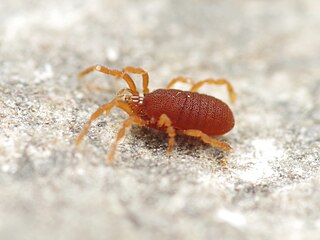
The Opiliones are an order of arachnids colloquially known as harvestmen, harvesters, harvest spiders, or daddy longlegs. As of April 2017, over 6,650 species of harvestmen have been discovered worldwide, although the total number of extant species may exceed 10,000. The order Opiliones includes five suborders: Cyphophthalmi, Eupnoi, Dyspnoi, Laniatores, and Tetrophthalmi, which were named in 2014.

Opilio is a genus of harvestmen with 35 known species.

Dyspnoi is a suborder of harvestmen, currently comprising 43 extant genera and 356 extant species, although more species are expected to be described in the future. The eight families are currently grouped into three superfamilies: the Acropsopilionoidea, Ischyropsalidioidea, and Troguloidea.

Cyphophthalmi is a suborder of harvestmen, colloquially known as mite harvestmen. Cyphophthalmi comprises 36 genera, and more than two hundred described species. The six families are currently grouped into three infraorders: the Boreophthalmi, Scopulophthalmi, and Sternophthalmi.

The Sironidae are a family of harvestmen with more than 60 described species.

The Neogoveidae are a family of harvestmen with 27 described species in eight genera. However, eight species of Huitaca, 17 species of Metagovea and 12 species of Neogovea are currently awaiting description.

Siro is a genus of mite harvestmen in the family Sironidae with 7 described species. All are found in Europe.
Arhesiro clousi is a species of mite harvestman in the family Sironidae.. It is found in North America, specifically USA, Oregon, Lincoln County.
Arhesiro sonoma is a species of mite harvestman in the family Sironidae. It is found in North America, specifically USA, California, Sonoma County.
Holosiro shasta is a species of mite harvestman in the family Sironidae. It is found in North America, specifically California, Shasta county.

Nemastomatinae is a subfamily of harvestmen with over 125 described species in 19 (extant) genera. They are usually found in temperate regions.
Parasiro is a genus of harvestmen belonging to the family Parasironidae with one described species. It is found in Southwestern Europe.
Cyphophthalmus is a genus of harvestmen belonging to the family Sironidae. It is found in Europe notably with several species in the Balkans and Turkey.
Arhesiro is a genus of mite harvestman in the family Sironidae. It is found in North America, only in the USA, with one species in California, another in Oregon.
Holosiro is a genus of mite harvestman in the family Sironidae. It is found in North America, only in the USA, with one species in California, another in Oregon.
Neosiro is a genus of mite harvestman in the family Sironidae. It is found in North America, only in the USA.
Parasironidae is a family of harvestmen with 7 described species.

Ebrosiro is a genus of harvestmen belonging to the family Parasironidae, it is monotypic with one described species. It is found in Southern Europe.
Tirrenosiro is a genus of harvestmen in the suborder Cyphophthalmi with two described species. Both species are found in Southern Europe.





